The Crime Reporter and the Cop: “A Hollywood Homicide True Life Detective Story” With a Surprising Twist of Destiny
July 18, 2024
Birch Bay, Washington
I joined the LAPD at age twenty-one in 1963. After being assigned to and working uniform patrol at four divisions (WLA, Van Nuys, Wilshire, and Hollywood), I transferred to Hollywood Detectives and worked all the “tables.” I started in the Juvenile Unit, then rotated to the Burglary Detail, then Auto Theft, Sex Crimes, Robbery, and finally to the Homicide Unit. I continued working in Homicide for the next sixteen years and handled over three hundred murder investigations. During my career, I conducted numerous interviews with the press. The following case takes us way back to 1980. A two-part story that appeared on June 23-24, 1980, on Page 1 of the Herald Examiner entitled, “Detective Story: The mystery death of the butcher’s mother–Did one of their fights end with her murder? The article was written by then Herald Examiner crime reporter Bruce Henderson who as a “ride along” followed the investigation with me and my partner, Bernie Skiles.
Here is crime reporter Bruce Henderson’s two-part, two-day write-up “Detective Story” as it appeared in the Herald Examiner in 1980:
Part I

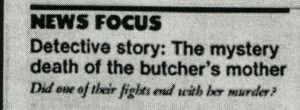
![]()
NEWS FOCUS
Detective story: The mystery death of the butcher’s mother
Did one of their fights end with her murder?
By Bruce Henderson
Herald Examiner staff writer
Los Angeles Police Department Homicide Detective Steve Hodel looked carefully at the nude body stretched out on the stainless-steel gurney in the hallway at the county coroner’s office.
Identified by a plastic tag attached by wire to her big toe, this was the body of Gloria Ford (not her real name), age 49, one of the 5,956 corpses handled by the coroner’s office to date this year. She had died a few hours earlier at Queen of Angels Hospital of an apparent brain hemorrhage after being brought in the night before by a Fire Department rescue ambulance.
The reason Detective Hodel was here at one o’clock in the morning was to inspect the extensive bruises on her head, shoulders, arms, and torso—which caused the coroner’s office to report the case to police as a suspicious death.
“There’s another one on the buttocks,” said the deputy coroner, a thin, pale man wearing rubber gloves. “No more than 48 hours old, same as these.”
The detective’s attention went back to the large black-and-blue bruise covering her forehead, stopping just above the sightless brown eyes.
“She was running a 2.0 blood alcohol when she got to the hospital,” said Hodel. “She was certainly in no condition to defend herself.”
Hodel had seen enough. Although he couldn’t be sure of the cause of death until the autopsy, he saw plenty of evidence of “blunt-force trauma”—the official term used to describe a vicious beating at the hands of another person.
So, he had no choice but to treat the death of Ford as Hollywood’s latest homicide.
The deputy coroner mumbled, “I better get her back into refrigeration.” He opened a nearby door and rolled the gurney into a large, cold room filled with dozens of other corpses of varying sizes, shapes, colors, sexes, and ages, all prostrate on gurneys awaiting autopsies.
Hodel walked down the hallway with his partner for the night, Detective Bernie Skiles.
Out in the parking lot, Hodel lit his seventh Pall Mall of the hour.
At 6 feet 2 and 206 pounds, with closely cropped graying hair, Hodel displays the easygoing demeanor of a big man who doesn’t have to prove anything.
“Seeing a dead body is one of the strongest arguments for religion,” he observed softly, inhaling deeply on the smoke. “Because without that spirit of life, the human body is just a piece of meat.”
Driving the unmarked police car north on the deserted Hollywood Freeway—heading back to precinct headquarters—Hodel explained that a visit to the morgue has always had a strong effect on him. “Seeing the victim’s body personalizes the case real fast.”
For Hodel, this case began with a telephone call a few hours earlier as he was sitting down to watch a TV movie with his wife Marsha at their Eagle Rock home. The downtown robbery-homicide detail was on the line, requesting that he take over the Gloria Ford “undetermined death” case since the victim had lived in Hollywood.
Hodel, 38, a 17-year veteran of the force, activated his videotape machine to record the movie for later viewing. Then he dressed in a gray polyester suit as his wife filled a quart thermos with hot black coffee.
Arriving at Hollywood precinct at 9:50 p.m., he took out a black leather belt from his desk drawer and strapped it around his waist. Attached to the belt and resting on his left hip was a snub-nosed .38. Pinned on the other side was a shiny badge.
Hodel has never fired his weapon in the line of duty, although he “had several opportunities—but always selected another option.”
After returning from the coroner’s office Hodel began working the telephone.
Detective Steve Hodel at Hollywood Division
June 23, 1980
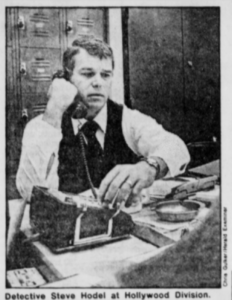
“This is Detective Hodel at LAPD Hollywood homicide,” he said in a call to the hospital where the woman had died. “Checking on a Gloria Ford, who was transported by R.A. (rescue ambulance) from her home early this morning around 3 a.m. Do you know how the call came in? And I’d like to talk to a doctor who examined her.”
Within 30 minutes, Hodel found out that the woman’s son, James Ford (not his real name), had called the Fire Department and reported finding his mother unconscious on the floor. And he had since visited her twice in the hospital.
“From the time she hit the emergency room, her prognosis was very poor,” the examining doctor explained to Hodel. “She remained on minimal life support and in a coma until she was pronounced dead.”
“What about the bruises?”
“Some looked very fresh,” the doctor continued.
“Can you give an initial indication of death,” Hodel asked.
“It’s hard to figure,” the doctor said. “She had the high blood-alcohol level. The brain scan showed massive cranial bleeding. Beyond that, I just don’t know.”
Hodel’s next call went to the manager of the rundown, five-story apartment house near Sunset and Highland, where the victim lived with her 22-year-old son.
The manager reported that the mother and son were always fighting, and she had received occasional beatings from him. He said the mother drank a lot; the son was a meat cutter by trade.
“Homicide investigations are like chess games,” Hodel said between phone calls. “First are the opening moves. Then the middle game, and finally the end game, which hopefully is prosecution and conviction.”
Clearly, the opening moves in the Gloria Ford case were focusing on her son. He had become the likely suspect because of the past beatings.
Next, Hodel telephoned the police computer records system. “Give me anything you’ve got on James Harold Ford, DOB 1-3-58, address…”
Bingo. Five arrests in the last four years, all of a violent nature—resisting arrest, assault on a fireman, attempted robbery, carrying a concealed weapon.
“Now I remember this turkey,” Skiles said suddenly. A 10-year veteran of the force, Skiles is in his third year on homicide. “I handled his assault on a fireman. He flips out against authority. He can be crazy, and he’s a big guy, about 6 feet tall and 220 pounds. We’d better be careful.”
It was 3 a.m. when Hodel picked up the phone and asked for a patrol unit to back them up in their anticipated confrontation with the son.
While waiting for the other officers to come in out of the field, Hodel said, “Now we’re getting into a gray area when it comes to the Miranda decision. Once we begin focusing on him as a suspect, we’re required to Miranda-ize him—read him his rights.
“But we’ll go out there and bring him back here. It’s important to get him on our own turf. We’ll get his story and let him come up with a rational explanation.”
“Maybe he’ll cop out,” Skiles said hopefully.
“Let’s hope so. Otherwise, it’s going to be a tough case,” Hodel admitted. “It’s been 24 hours since she was found. That’s a long time for someone to clean up the crime scene.”
Two hefty, uniformed officers came into the squad room. “We hear you want police protection,” joked one of the patrolmen.
“We don’t think we’ll have any trouble,” Hodel said evenly. “But you never know.”
Tomorrow: Detectives interrogate a murder suspect and solve the Gloria Ford case.
Part 2
June 24, 1980


![]()
It was 3:40 a.m., and the urine-soaked, carpeted hallway in front of Apartment 405 in the dingy, 5-story Hollywood apartment building was crowded with four Los Angeles Police Department officers.
Standing flush against the wall next to the door was Homicide Detective Steve Hodel, 38, a 17-year veteran of the force.
Across from Hodel, on the opposite side of the doorway, was his partner on the case, Detective Bernie Skiles. Two uniformed officers stood nearby.
With his ear to the door, Hodel listened to the sound of radio music coming from inside the apartment, where until 24 hours earlier, Gloria Ford, 49, had lived with her occasionally violent son.
The woman now lay dead on a gurney in a refrigeration room at the county coroner’s office, the victim of an apparent brain hemorrhage after being brought in by ambulance from her apartment the previous morning.
Although an autopsy was scheduled for later in the day to determine the exact cause of death, the heavy bruises on her head, arms, and torso were suspicious enough to cause Hodel to treat this as Hollywood’s 18th homicide of 1980.
And her 22-year-old son, James Ford (not his real name), a meatcutter by trade, had become a likely suspect after neighbors told Hodel that he had a reputation for beating his mother, who was known to be a heavy drinker.
In the last few hours, Hodel had also learned that the son had five previous arrests in the past four years on offenses involving violent behavior.
“There can be a lot of hatred in a family with an alcoholic,” Hodel had said on the ride to the apartment house. “I’ve seen it time and time again.”
Hodel knocked firmly on the door.
“Who is it?” came a loud, wary voice from the other side of the door.
“Hi, Jim, this is Detective Hodel of LAPD.” There was no threat in the cop’s voice—only concern and understanding. “I’d like to talk to you about your mother.”
The door swung open. Jim Ford, a beefy man dressed in faded jeans and a dirty T-shirt, was genuinely surprised to see four policemen at his doorway.
“Sure, I’ll talk to you.” His voice cracked, betraying nervousness. “Anything you want to know, I’ll tell you—come on in.”
“No, Jim, we’d like to talk to you at the station,” Hodel said easily. “Why don’t you get your coat, and we’ll give you a lift.”
At 4:05 a.m., Hodel showed Ford into Interrogation Room 110 at Hollywood Division headquarters.
It was a small room, sparsely furnished with a Formica-topped desk, four chairs, and two metal ashtrays, and illuminated by two white fluorescent lights overhead.
Everything being said in the room was being recorded on tape, and a large two-way mirror on the wall allowed observers in an adjacent room to watch the questioning.
The son began talking nervously about everything but his mother.
Hodel, with a yellow legal pad and his second pack of Pall Malls of the night in front of him, asked Ford to start from the beginning.
The son told of entering the unlocked apartment, hearing his mother gasping for breath, and finding her on the floor just outside the bathroom.
“There was blood in her mouth. I hit her throat.”
“You hit her in the throat?” asked Hodel.
“Yes, very lightly. I was trying to clear an air passage. Look, I’ve taken first-aid training.” He opened his wallet and showed Hodel an advanced first-aid card.
“I saw her dinner nearby,” Ford continued. “It was shrimp and wine. I thought maybe she could have choked on a shrimp tail. It’s very easy to choke on a shrimp tail, you know.”
Ford said he called the paramedics and watched them work on his mother for more than an hour before they took her to the hospital.
At 5:10 a.m., he broke down and cried for the first time when he described what his mother looked like when he visited her in the hospital.
“Her eyes were taped shut…I grabbed her wrist…I know she was in a coma and everything, but I think she knew it was me. She turned her hand over and held my hand.”
Ten hours later, Ford said, the hospital called to tell him that his mother had died. “I wasn’t surprised. They told me from the beginning that she didn’t have much of a chance.”
“Did you and your mother ever fight?” Hodel asked cautiously.
“Oh, yeah, all the time,” Ford admitted. “She didn’t like my job or my friends. She wanted me to get my own apartment.”
“Did you ever hit her?”
Ford moved nervously, his eyes averting Hodel. “Maybe a little slap on the arm.”
“Did you ever hit her around her head or body?”
“Oh, no., never. She bruised easy, though. She was always getting drunk and falling down. A couple of nights ago, I came home, and she was passed out on the floor. I picked her up and put her on the couch, and the next morning, both her arms were badly bruised. My mother is – I mean was –very fragile.”
During a break in the interrogation, Hodel telephoned the coroner’s office to plead with the duty doctor for a quick autopsy on Gloria Ford.
“It looks like a 187 homicide, and we’ve got a possible suspect—her son—who is cooperating with us at the present time,” he explained softly so Ford couldn’t overhear him. “I’d sure appreciate it if you could schedule it for today. We want to put him on the polygraph before he boogies.”
Hodel has worked homicide for nine years, and he’s good at his job. A big, easygoing guy, he approaches his cases methodically and isn’t given to brash moves that some cops make without thinking. Hodel is a thinker, not a cowboy.
He’s solved dozens of homicides over the years, and several of his convicted murderers are on death row. Yet Hodel is personally opposed to capital punishment.
The proud father of two small sons, ages 1 and 2. Hodel says his oldest son, Mike, “wants me to be a fireman when I grow up.”
Two hours later, Hodel had Ford’s entire story. The questioning had been polite, objective and detailed.
At the end, Ford had given permission for the police to search his apartment and handed over the door key. He had also agreed to take a polygraph test within the next few days.
Ford laughed uneasily as he stood to leave the room. “Boy, you guys are acting like you think I killed my mother.”
“It’s our job, Jim, to conduct an investigation when there’s bruising on the body and when the cause of death is undetermined,” explained Hodel.
Hodel told Ford he could leave and asked him to stay away from the apartment for an hour.
On the way out of the station, Ford ran into a uniformed officer who knew him from an earlier arrest.
“What are you doing here, Ford?” the cop asked.
“My mother just died,” he explained. “They’re acting around here like I killed her.”
“I wouldn’t doubt it.” Said the cop, walking away.
Ford came running back into the squad room, angry at the encounter and threatening to withdraw his permission for the search.
Hodel calmed him down, and he finally left.
Detective Steve Hodel worked on the case for 26 straight hours
June 24, 1980
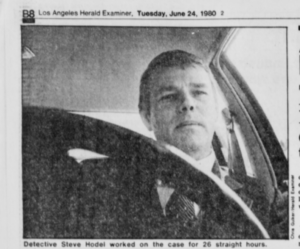
On the drive to the apartment, Hodel admitted he was disgusted with the behavior of the uniformed officer. “That’s the kind of unpredictable thing that can cost us a case,” he said.
Did Hodel think this was a homicide?
“Some of his responses were those of a guilty man. But you can’t believe these early green lights. You have got to keep an open mind.”
At the Ford apartment, Hodel and Skiles searched through drawers under beds and couches and noted several bloodstains where Ford said he had found his mother.
Nothing incriminating was found, and a police photographer and criminologist were called to the scene to complete a routine examination of the premises.
The neighbor across the hall said the mother and son used to fight a lot but she had been home the night in question and heard nothing from the Ford apartment.
“What do you think?” Hodel asked Skiles.
“I’m thinking about those bruises on her forehead,” said Skiles. “Maybe she could have gotten them from falling face forward on the floor.”
“I’m glad to see you’re keeping an open mind,” said Hodel. “The crucial thing now is the autopsy.”
In a real sense, Dr. J. Lawrence Cogan of the Los Angeles County Coroner’s Office solved the Gloria Ford case for Homicide Detective Steve Hodel.
Cogan’s autopsy, completed four hours after the interrogation of Jim Ford ended, showed that her death came from “spontaneous intracerebral hemorrhage—due to natural causes.”
The bruises on her body were fresh and probably caused within the past 48 hours, said Cogan, but none of them were of sufficient nature to have been contributory factors in her death. They could have been caused by a “minor assault or accidental falling.”
A secondary cause of death was listed as cirrhosis of the liver.
“So, Jim didn’t kill his mother,” Hodel said over an egg omelet brunch at Lou’s Quickie Grill on Santa Monica Boulevard—his first meal in 18 hours. During that time, he drank more than a quart of black coffee and smoked two packs of Pall Malls. He was tired now, but he was also satisfied with the results.
“Why did he act suspicious?” Hodel asked rhetorically. “Because he had beaten her in the past, and he himself wasn’t sure if he had contributed to her death. But the medical evidence shows he had nothing to do with her death. And I’ll call and tell him that.”
Hodel sat back and lit a cigarette. “This is why you always have to keep an open mind in this business. And you can see why “beyond a reasonable doubt” is so important.”
At 2 p.m. that afternoon, Hodel went home to bed after working 26 hours straight out of Hollywood Homicide.
THE AFTERMATH—
Subsequent to this two-day newspaper article written forty-five years ago, the crime reporter and the cop went their separate ways. One was to pursue his chosen career as a journalist, and the other to continue his career working as a detective assigned to Hollywood Homicide. But, bizarrely, their futures would merge and meet again. Here’s how.
The Reporter:
Bruce Henderson- From Herald Express crime reporter to NYT Best-Selling Author
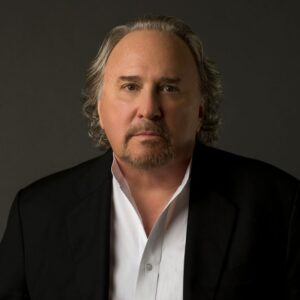
Bruce Henderson, NYT and International Bestselling Author
Bruce Henderson is the author of more than thirty nonfiction books, including a #1 New York Times bestseller that was made into a highly-rated television miniseries. His books have been published in twenty countries.
He won the tenth annual Gilder Lehrman Military History award in recognition of the best English language book published in 2022 in the field of American military history for his latest book, Bridge to the Sun: The Secret Role of the Japanese Americans Who Fought in the Pacific in World War II. It is a gripping true tale of courage and adventure—the saga of the Japanese American U.S. soldiers who fought in the Pacific theater against Japan, their ancestral homeland, even as their families back home in America were being rounded up and held behind barbed wire in government internment camps.
A former newspaper reporter, magazine editor, private investigator, and field producer for television news, Bruce has taught reporting and writing courses at Stanford University and USC School of Journalism. A member of The Authors Guild, he lives outside San Francisco, California.
And the Cop:
Steve Hodel, from LAPD Homicide Detective to NYT and International Bestselling Author


Steve Hodel
2023
I, too, would finish my career in the LAPD after serving another six years at Hollywood Homicide. I had no thoughts of becoming a writer, but fourteen years into retirement, fates would determine otherwise. At my father, Dr. George Hill Hodel’s death in 1999, a few casual remarks from my half-sister, Tamar, would start me into the investigation to clear our father of any suspicion or involvement in the 1947 Elizabeth Short “Black Dahlia” murder. Just as in the 1980 Ford Unfounded Death investigation some twenty years in the past, my investigation was a chess game. There would be some opening moves, a middle game, and the end game, which, to my astonishment, took me 180′ in the opposite direction of what I expected. Proofs beyond a reasonable doubt that my father did commit the Short and numerous other serial L.A. Lone Woman Murders. It would force me to write Black Dahlia Avenger and an additional series of eight books documenting his suspected serial crimes spanning fifty years.
Author Note-
Bruce Henderson and I met for the first time on that 1980 “ride-along” reportage and have remained friends through the decades. Our lives took us initially in different directions and to different locales: I to Bellingham, Washington, and Bruce to Northern California. But then, we circled back as we both met as NYT’s Best-Selling authors. We have kept in touch and remain friends to this day.
The original Herald Express articles Parts I and II 1980:
Los_Angeles_Herald_Examiner_1980-06-23_1
Los_Angeles_Herald_Examiner_1980-06-23_6 (1)
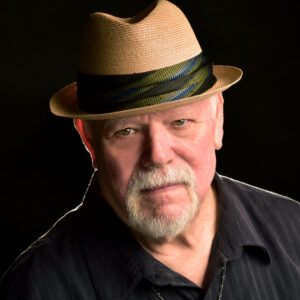
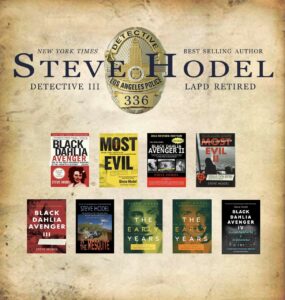
Wow Steve, feel like I’ve just watched a combination episode of Kojak & Quincey!! You and Bruce Henderson hopefully enjoying your well-deserved retirements! And sounding like a mother here…..you’re lucky you’re still here with all those Pall Malls over the years……they were pretty strong…..my faves were Marlboro or Tareyton! You write well Steve, very well! Perhaps in the next life we’ll meet as “true crime” author and book illustrator! We can discuss projects over a few ciggies with Chardonnay & Johnny Walker Black! Hmm….where?……San Francisco or L.A? Maybe in between in Carmel & Clint can join us,…… plan a movie ☺️!
Sound like a plan👍? Stay well Steve 😎🌵
Patricia O:
Hey mom! Yeah, I never shot or got shot at during my 24-year career on LAPD (which included the six days of the Watts Riots in August 1965.) But, I sure missed a bullet with the smoking of two packs of Pall Mall Reds a day for forty-two years! Quit drinking and smoking in 1999 at age 58. I had forgotten all about this 1980 “ride-along/reportage” by Bruce until a certain curmudgeon happened to mention it in one of his rants, which caused me to look it up on Newspapers.com and bingo. There it was. All Best to you, Patricia.
Steve, what a great insight into your detective life before you investigated your father’s macabre killings. I feel honored to be your friend and a caretaker of the love of your life – dear Rima! I’m glad Village Books here in the Bellingham area is giving you the recognition you’re due. Still, I won’t be happy until my prayers come true – that your books regarding the Black Dahlia (and the numerous other sadistic killings) are presented in cinematic form.
Vanessa V:
Thanks for the kind words. And big licks from Rima for being so close and boarding her on occasion so she doesn’t have to go to do any “hard time” in the formal dog hotels. Yes, enjoyed giving the talk at Village Books Lynden and will be doing a second one at Fairhaven Village Books in probably October. Fingers,toes, and paws crossed for a book to film or book to television series in the not-too-distant future. Working to make that happen. Best, Steve
So cool to read something by and about two old friends! “A thinker not a cowboy” And glad you gave up smoking!
Hi Marcus. me too Smoking was so 40s. sure miss our poker games though. now that I’m closer hope to get to see you one of these months.
Steve!
Steve!
Steve!
Onyxx and I join in the Sacred WombSpace to send you a cleansing, centering breath and powerful VIBRATIONS for ancestral HEALING! Ancestral HEALING is the ancient practice of connecting to our forefathers and foreMOTHERS to dispel the negative energies of past generations and replace them with purest LOVE 💖💖💖💖 Pure LOVE! 💖💖💖💖 The message of ancestral healing never grows old! It is timeless! Feel our MINDFULNESS! Our Thoughtprayers are for YOU!
Peace to you🙏🏻
Peace to Brother Kel🙏🏻
Peace to FaunaElizabeth 🙏🏻
Peace to powerful Dorero of the Sacred WombSpace 🙏🏻
Peace to noble Rima, earthly Guardian of Steve 🙏🏻
Peace always🙏🏻🙏🏼🙏🏾🙏🏿
Yolie💎
Onyxx💎
Rap’cha has Covid! Kristel is caring for her and Boogers the rescue cat. Her sores are almost gone!
Steve, if we had more people like you working in the police departments of our major cities, our crime rates would be steeply lower, our solve rates higher, and our cities would be paying far less money in compensation for cases of excessive force and wrongful death. I’m only grateful for the excellent police officers we do have and hope there are always men and women like you who are willing to do that demanding and often dangerous and thankless job.
Thank you for your decades of excellent service and for your intelligence, decency, and dedication to justice, though it was in a different city than mine.
Laura:
Thanks mucho for the kind words. Have really enjoyed being of service to “The People” through the years. So many opportunities to assist others in small and big ways. Been a priveldge to serve. Steve
Hi Steve,
This was almost like a script for a true crime series (I have watched way too many over the years… not). You could call it “Keep an Open Mind”.
Detectives who do what you did are what make the wheels of justice work true. to form Thanks for doing that. Your example should be a model for all impatient detectives that jumping to conclusions is not such a good thing. Patience is everything since so much is at stake on both sides of the law.
Are there any plans to cover some of your most memorable cases? Or has working on the BD and other cases of GHH given you enough of that?
Keep up the great work on your blog and other projects. And have a great day and stay cool.
Ron:
Thanks Ron. I enjoyed writing “The Snake and Bake Murder” which was one of my real cases from the Seventies. Most unusual investigation. As far as writing others, not sure. As you say, have had my hands full with my father’s crimes spanning fifty years. Bit of a burn out now, but maybe will find new breath “down the road”? Hoping to see a book to film or book to series happen, which would keep me busy too.https://stevehodel.com/2020/02/03/the-snake-bake-murder-my-1974-hollywood-homicide-division-murder-investigation-now-available-as-ebook-standalone-short-story/
Best, Steve